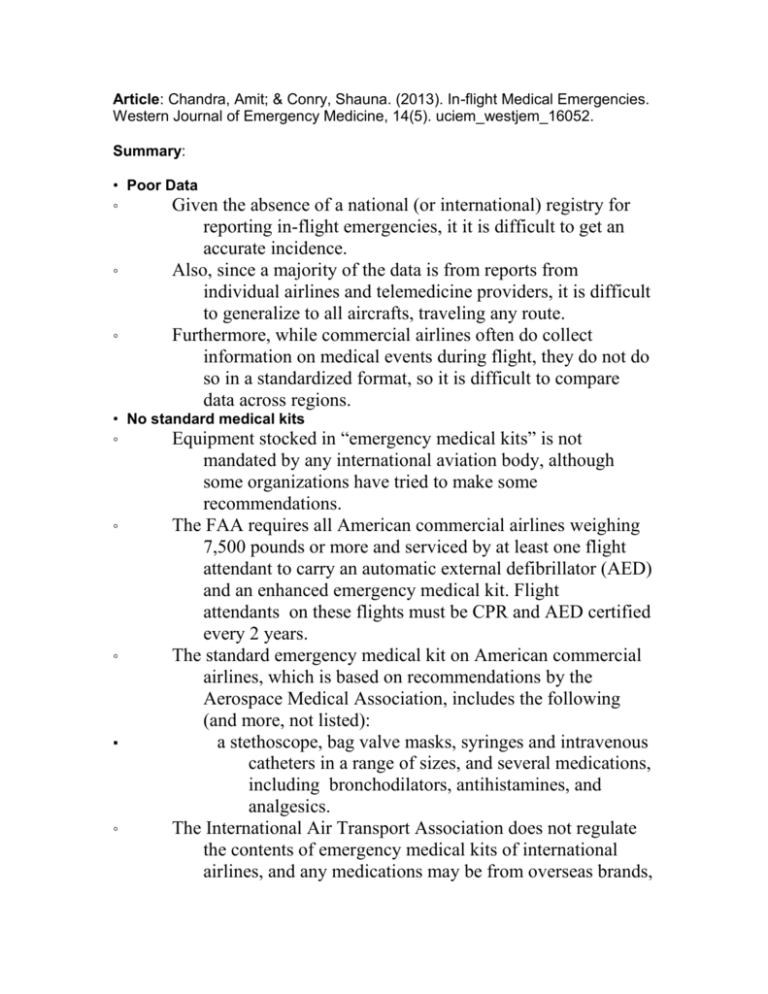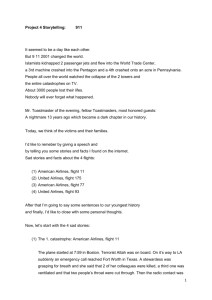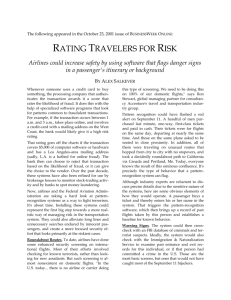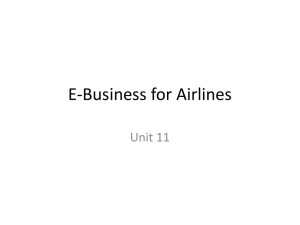Inflight-Medicine-Sumary
advertisement

Article: Chandra, Amit; & Conry, Shauna. (2013). In-flight Medical Emergencies. Western Journal of Emergency Medicine, 14(5). uciem_westjem_16052. Summary: • Poor Data ◦ Given ◦ ◦ the absence of a national (or international) registry for reporting in-flight emergencies, it it is difficult to get an accurate incidence. Also, since a majority of the data is from reports from individual airlines and telemedicine providers, it is difficult to generalize to all aircrafts, traveling any route. Furthermore, while commercial airlines often do collect information on medical events during flight, they do not do so in a standardized format, so it is difficult to compare data across regions. • No standard medical kits ◦ Equipment stocked ◦ ◦ ▪ ◦ in “emergency medical kits” is not mandated by any international aviation body, although some organizations have tried to make some recommendations. The FAA requires all American commercial airlines weighing 7,500 pounds or more and serviced by at least one flight attendant to carry an automatic external defibrillator (AED) and an enhanced emergency medical kit. Flight attendants on these flights must be CPR and AED certified every 2 years. The standard emergency medical kit on American commercial airlines, which is based on recommendations by the Aerospace Medical Association, includes the following (and more, not listed): a stethoscope, bag valve masks, syringes and intravenous catheters in a range of sizes, and several medications, including bronchodilators, antihistamines, and analgesics. The International Air Transport Association does not regulate the contents of emergency medical kits of international airlines, and any medications may be from overseas brands, • ◦ ◦ • ◦ ◦ ◦ ◦ ◦ • ◦ ◦ • ◦ ◦ different then those used in the U.S. This study This study was a retrospective data MEDLINE search, looking between 1980 to 2010, looking for terms relevant to aviation medical emergencies and extracted incidence studies and high quality topic summaries. They then reported the incidences and top diagnoses from the studies they found. Incidence guesses Most incidence guesses were from medical assistance companies or from individual airlines or airports. MedAire, a medical assistance company that provides remote assistance to several commercial airlines in the United States, responds to an average of 17,000 cases per year. One study using a single airline over 1 year found the incidence of medical incidents to be 1 per 11,000 passengers. Another study using 2 European airlines over the course of 5 years, found an incidence of 14 incidents per billion passenger kilometers. Lastly they discussed a third study of a 5-year retrospective cohort that demonstrated an incidence of 11.6 cases per billion passenger kilometers. Top diagnoses Syncope, gastrointestinal upset, and respiratory symptoms were among the common medical complaints reported. Chest pain and cardiovascular events were also noted, and these cases were often associated with diversion. Diversion If the patient’s condition is unstable and requires immediate formal medical attention, the physician may recommend diversion of the flight to the nearest airport capable of landing the aircraft and with access to appropriate medical facilities. Generally it is asked that the person with the most relevant expertise or experience be involved in making this decisions (i.e. a neonatologist may defer to an ED nurse or advanced paramedic). ◦ The act of diverting a full aircraft to the nearest city is expensive, estimated as high as $100,000 . Diversion is usually made in consultation with ground-based medical expertise and should account for regional medical resources along the flight path.











